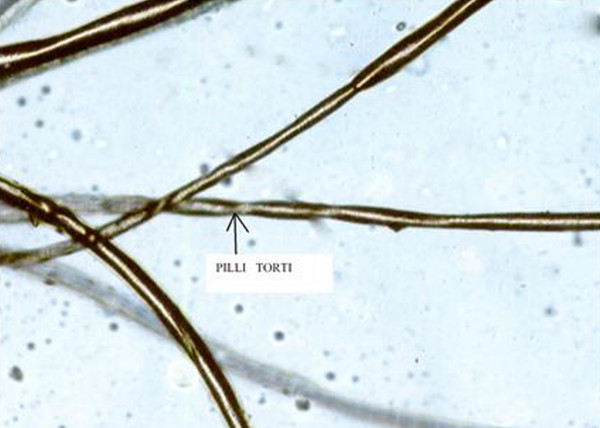Pili Torti, Early-Onset

Description
Pili torti, or twisted hair, is a condition in which the hair shafts are flattened and rotated along their long axis. Hairs are fragile and break at short length. Some patients may have associated dental or nail findings, and many have resolution of the fragile hair at puberty (review by Dawber, 1996).
Pili torti is also a feature in several disorders, including Bjornstad syndrome (BJS; 262000), Bazex syndrome (BZX; 301845), and Menkes disease (309400).
Clinical FeaturesPili torti was first described and named by Ronchese (1932), who observed 2 affected Italian sisters. The proband had dull blonde scalp hair that was 'lank and frizzy, with a wild, bushy appearance.' The hairs were very fragile, and broke spontaneously or with mild trauma. Close examination showed that the hair shafts were flattened at irregular intervals and were sharply twisted through 180 degrees about their axes. The eyebrows appeared similarly affected, but the eyelashes were not. Keratosis pilaris was also noted on the lower limbs and the rest of the body.
Gedda and Cavalieri (1963) reported 6 families; in 2 families, the parents were related, and in 2 others, 2 sibs were affected. None of the parents was affected. Some affected individuals had hypoplastic dental enamel, and in some cases, hair became normal at puberty.
Gelles (1999) reported a 4-year-old girl with pili torti. She had poor hair growth from birth, with hair loss at age 8 weeks. The blond hair that regrew was sparse and brittle, with easy breakage, and shimmered in reflective light. Nails, hair, and teeth were normal. Microscopic analysis showed flattened hair shafts that were twisted around the long axis, usually at 180 degrees, but ranging from 90 to 360 degrees. There were multiple broken hairs showing trichorrhexis nodosa (fractured hair with the ends stuck together resembling broomsticks).
InheritanceAutosomal dominant and autosomal recessive inheritance have both been suggested (Gedda and Cavalieri, 1963).
Appel and Messina (1942) described an affected girl whose brother, sister, paternal aunt, and paternal grandmother were also affected.